|
Native plants that developed in the remote Hawaiian Island chain found their own special niche and fragile balance. But they now face tremendous threats from alien invasive plants, brought to the islands by humans. The species listed below are just some of the most notorious varieties that are displacing native plants from their habitat. For notable animals disrupting the ecosystem, see the Invasive Animals page. 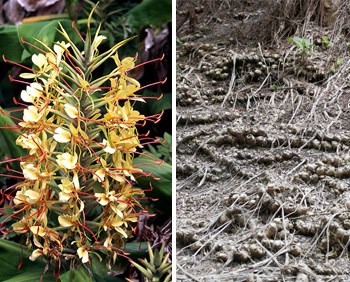
Himalayan GingerPurposely introduced into park housing as an ornamental plant in the 1940s, Himalayan ginger (Hedychium gardnerianum), is also known as Kāhili ginger because it resembles the feathered staffs of Hawaiian royalty. This inedible variety of ginger spreads via rhizomes (underground stems) or birds eating and spreading the seeds to remote parts of forests. Kāhili ginger then dominates the forest understory, hindering the growth of other understory species, such as ferns, and the regeneration of native trees. It can be identified by its seven foot tall shoots and large, glossy, dark green leaves. In summer, Kāhili ginger sports red and yellow flowers and in late fall and winter, has round orange fruit capsules that open to reveal red seeds. 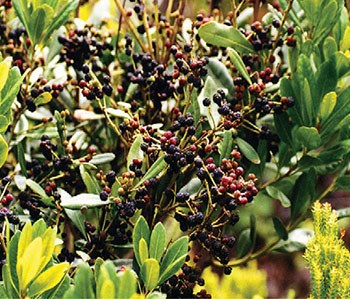
FayaOriginating from the Canary islands, Morella faya was most likely brought to the Hawaiian Islands by the Portuguese in the 1800s as an ornamental plant and for its berries, which were used in wine making. While Faya was later used in reforestation efforts among several of the Hawaiian Islands, it was considered an invasive species by 1937. It is found throughout the park and hinders the growth of native plants by changing the soil pH and shading out native understory species. Faya initially has a shrub-like appearance with smooth, light colored bark, but grows into a medium sized tree. The leaves are oblong, toothed, and dark green, although new growth has a bright green hue. Small flowers become small black or red berries, which are eaten and spread by birds. To control the spread of Faya, the trees are girdled and herbicide is applied. 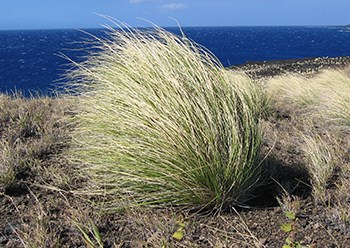
Fountain GrassFountain grass originates from Africa and was brought to Hawaii as an ornamental species. It was accidentally introduced to the park in the 1960s, but eradication and containment strategies did not begin until the 1970s, which was when it was labeled as an invasive species. It grows in three foot tall clumps, has rolled leaves, and is topped with 4-10 inch red-purple flower spikes. It is dispersed by wind and mostly found in dry areas such as fresh lava flows, rangelands, and the roadsides of Kona. Fountain grass is highly flammable and adapted for wildfires, which has caused it to outcompete many native species and now covers more than 200,000 acres of land on the Kona side of the Big Island. 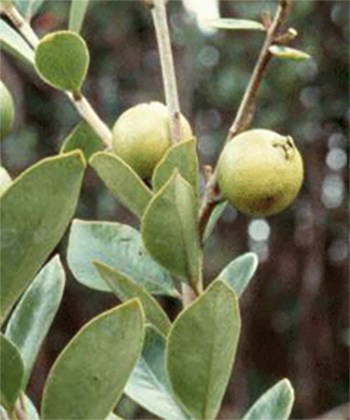
Strawberry GuavaAlthough its fruit may be delicious and is used in many food products, strawberry guava (Psidium cattleianum), also known as waiawi, is considered to be one of the worst invasive species in Hawaiʻi. Native to Brazil, the species was likely introduced to the islands in 1825. Since then, it has taken over large swaths of native forest and according to the US Forest Service is capable of invading half the land area on Hawaiʻi Island. Once it is fully established in an ecosystem, it can form dense thickets that crowd out native plants and disrupt the flow of water, both of which in turn have an effect on animals. Compared to healthy native forests, forests invaded by strawberry guava lose over one quarter more water to the atmosphere, according to the Forest Service. 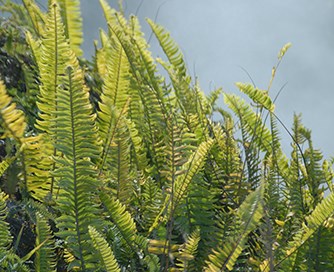
Asian Sword FernThis highly invasive plant native to southeast Asia is very visible in the summit area of Kīlauea, appearing to dominate certain areas of forest. Its leathery fronds look very similar to native species of sword fern, known as kupukupu. 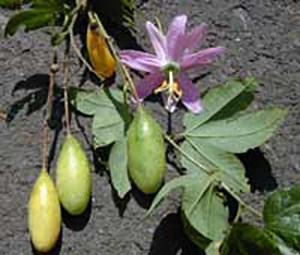
Banana Poka"Poka" in Hawaiian connotes climbing, and that is exactly what this invasive does. Banana Poka (Passiflora mollissima) climbs and smothers trees, with the potential to take over areas of forest with dense mats. It produces an elongated fruit that is yellow when ripe, the seeds of which are then spread by feral pigs and birds. This plant, which is a great threat to Hawaiian forests, can also be spotted by its showy, pink flowers.The requested video is no longer available.
|
Last updated: February 18, 2021
